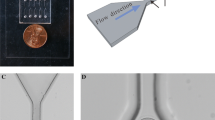Abstract
Rotation of a single cell is an indispensable cell manipulation technique for genetic studies and clinical applications. Conventional contact manipulation methods for rotation of a cell use complex control systems and tools, while conventional non-contact manipulation methods have limitations regarding the operating space or range of the rotated cell size. Here, we report on a convenient, non-contact, and open space method for a wide range of single cell sizes (micrometer scale to millimeter scale) rotating in a vertical plane (out-of-plane) of an open space. This method uses a vertical microscale recirculation zone for capturing and rotating the cell. We fabricated a micro-orifice on the surface of a microfluidic chip to generate the micro-recirculation zone and then carried out experiments on vertical rotations of Xenopus oocyte, embryoid body, brine shrimp oocyte, and zebrafish oocyte using this chip. We demonstrated the rotation of four types of cells in the vertical plane between the air–liquid interface and the top surface of the microfluidic chip; then, we conducted a simulation to analyze the dynamics of the vertical rotation of the Xenopus oocyte qualitatively. Our results indicated rotation speed of the four types of cells was controllable by the micro-recirculation zone. The size and density of oocytes also affected the process of capturing and rotation. We expect this method opens new research opportunities in three-dimensional cell manipulation, imaging, and analysis.







Similar content being viewed by others
References
Arakawa T, Noguchi M, Sumitomo K et al (2011) High-throughput single-cell manipulation system for a large number of target cells. Biomicrofluidics 5:14114. doi:10.1063/1.3567101
Beddington R, Gertsenstein M, Kristina Vintesten Nagy, Andras N (1999) Manipulating the mouse embryo: a laboratory manual, 4th edn. Cold Spring Harbor, New York
Benhal P, Chase JG, Gaynor P et al (2014) AC electric field induced dipole-based on-chip 3D cell rotation. Lab Chip 14:2717–2727. doi:10.1039/c4lc00312h
Bhagat AAS, Hou HW, Li LD et al (2011) Pinched flow coupled shear-modulated inertial microfluidics for high-throughput rare blood cell separation. Lab Chip 11:1870–1878. doi:10.1039/c0lc00633e
Elbez R, McNaughton BH, Patel L, et al (2011) Nanoparticle induced cell magneto-rotation: monitoring morphology, stress and drug sensitivity of a suspended single cancer cell. PLoS One. doi: 10.1371/journal.pone.0028475
Fuhr G, Müller T, Schnelle T, Hagedorn R (1994) Radio-frequency microtools for particle and live cell manipulation. Naturwissenschaften 81:528–535
Gianaroli L (2000) Preimplantation genetic diagnosis: polar body and embryo biopsy. Hum Reprod 15(Suppl 4):69–75
Grier DG (2003) A revolution in optical manipulation. Nature 424:810–816. doi:10.1038/nature01935
Hagiwara M, Kawahara T, Yamanishi Y et al (2011) On-chip magnetically actuated robot with ultrasonic vibration for single cell manipulations. Lab Chip 11:2049–2054. doi:10.1039/c1lc20164f
Hagiwara M, Kawahara T, Arai F (2012) Local streamline generation by mechanical oscillation in a microfluidic chip for noncontact cell manipulations. Appl Phys Lett 101:074102. doi:10.1063/1.4746247
Han S-I, Joo Y-D, Han K-H (2013) An electrorotation technique for measuring the dielectric properties of cells with simultaneous use of negative quadrupolar dielectrophoresis and electrorotation. Analyst 138:1529–1537. doi:10.1039/c3an36261b
Hu J (2014) Ultrasonic micro/nano manipulations: principles and examples. World Scientific, Singapore
Kaigala GV, Lovchik RD, Delamarche E (2012) Microfluidics in the “open space” for performing localized chemistry on biological interfaces. Angew Chem Int Ed Engl 51:11224–11240. doi:10.1002/anie.201201798
Kollmann W, Umont G (2009) Formation of a recirculation zone in low re-number turbulence. Comput Fluids 38:1424–1434. doi:10.1016/j.compfluid.2008.01.037
Leung C, Lu Z, Zhang XP, Sun Y (2012) Three-dimensional rotation of mouse embryos. IEEE Trans Biomed Eng 59:1049–1056. doi:10.1109/TBME.2012.2182995
Liang YY-L, Huang Y-PY, Lu YY-S et al (2010) Cell rotation using optoelectronic tweezers. Biomicrofluidics 4:43003. doi:10.1063/1.3496357
Lutz BRB, Chen J, Schwartz DTD (2006) Hydrodynamic tweezers: 1. Noncontact trapping of single cells using steady streaming microeddies. Anal Chem 78:5429–5435. doi:10.1021/ac060555y
Paterson L, MacDonald MP, Arlt J et al (2001) Controlled rotation of optically trapped microscopic particles. Science 292:912–914. doi:10.1126/science.1058591
Sacconi L, Romano G, Ballerini R et al (2001) Three-dimensional magneto-optic trap for micro-object manipulation. Opt Lett 26:1359–1361
Takeda N, Edagawa Y, Yamaguchi Y, Shoji S (2008) Microfluidic alignment system for single cell manipulation and culture. Twelfth International Conference on Miniaturized Systems for Chemistry and Life Sciences, μTAS 2008, San Diego, California, pp 1855–1857
Van Der Westerlaken La, Helmerhorst FM, Hermans J, Naaktgeboren N (1999) Intracytoplasmic sperm injection: position of the polar body affects pregnancy rate. Hum Reprod 14:2565–2569
Yalikun Y, Akiyama Y, Hoshino T, Morishima K (2013) A bio-manipulation method based on the hydrodynamic force of multiple microfluidic streams. J Robot Mechatron 1:611–618
Acknowledgments
This work was partly supported by JSPS KAKENHI Grant Nos. 21676002, 26249027, and 26560210, 15K11918, the Fluid Power Technology Promotion Foundation, and the Sasagawa Scientific Research Grant, Japan Science Society. We thank Dr. Yasunori Shintani (Department of Medical Biochemistry, Osaka University Graduate School of Medicine) for offering us the shrimp and zebrafish oocytes.
Author information
Authors and Affiliations
Corresponding author
Electronic supplementary material
Below is the link to the electronic supplementary material.
S.4. Capturing the Xenopus oocyte at different initial positions (1.04 and 1.52 mm from the activated orifice) (MP4 11877 kb)
Rights and permissions
About this article
Cite this article
Yalikun, Y., Kanda, Y. & Morishima, K. Hydrodynamic vertical rotation method for a single cell in an open space. Microfluid Nanofluid 20, 74 (2016). https://doi.org/10.1007/s10404-016-1737-y
Received:
Accepted:
Published:
DOI: https://doi.org/10.1007/s10404-016-1737-y




